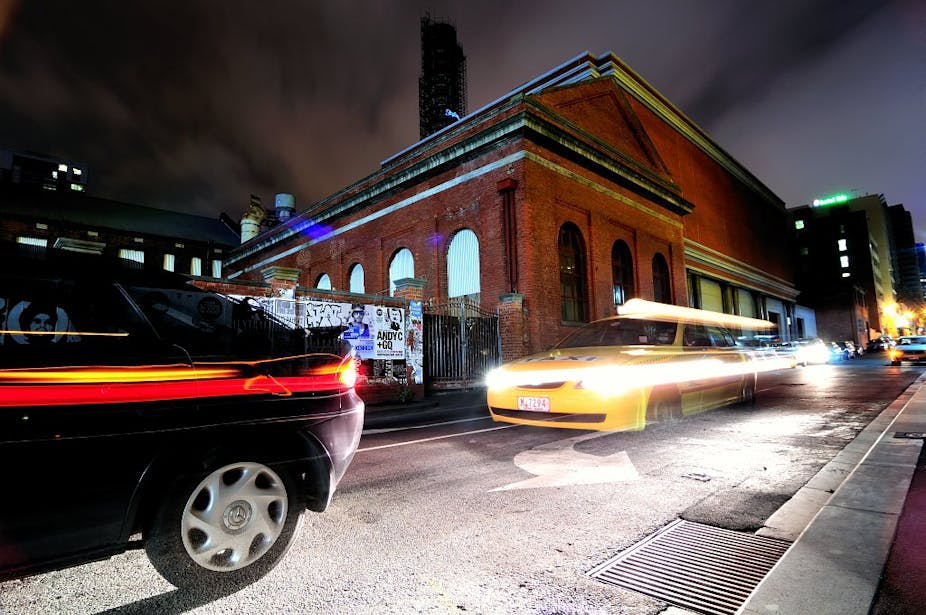There is an unexpected revolution underway in road safety. True, the highly visible community-wide programs continue, but behind the scenes there are major changes underway in how safety will be managed within road transport systems.
The self-driving car (or “autonomous vehicle”) has emerged with a practical suite of technologies for more efficient, safer, and eco-friendly road travel. This emergence has been rapid: for example, the Australian National Road Safety Strategy 2011-2020 did not canvas the possibility of such technologies.
The technology is already here
Self-driving cars are now approved for use on roads in several US states and may soon be on British roads. Self-driving cars are able to perform driving functions automatically. These vehicles use integrated systems of cameras, lidar, radar, and other sensors, as well as vehicle-to-vehicle (V2V) and vehicle-to-infrastructure (V2I) communications and GPS navigation. These systems monitor the road environment and respond to changing traffic situations, roadway and weather conditions, and navigate to a destination without intervention from the vehicle occupant.
From what was once regarded as a futurist concept, autonomous vehicles are emerging as commercially viable. While fully self-driving cars may well be a decade or more away, the components that are necessary for the development of such vehicles are already in the marketplace. These include electronic stability control, advanced braking systems, active lane keeping, as well as a range of other in-vehicle safety technologies. Trials are underway to better understand the integration of crash avoidance technologies with “connected vehicles” utilising V2V and V2I technologies.
So what can the automated car do to address the “fatal five” causes of road trauma: speeding, alcohol-impaired and drug-impaired driving, failure to wear a seatbelt, driving while fatigued, and driving while distracted?
The autonomous vehicle revolution will likely have its major effects on controlling transitory behaviours such as speeding and unsafe manoeuvres associated with driver lapses and errors, rather than impacting on driver impairment or intentional risky behaviour. A seat belt interlock will prevent vehicle occupants from travelling unrestrained. As well as addressing safety issues, aspects such as route planning to reduce or avoid congestion and ecodriving are likely to be addressed through autonomous technologies.
Drink driving
We all know that drink driving is a crime: random breath testing and years of public education campaigns have taught us that. But still tens of thousands of people across Australia get in their cars and drive after drinking. That behaviour is the cause of significant injury and harm. The Australian National Road Safety Strategy 2011-2020 noted:
“… while drink driving behaviour has been contained to a small proportion of the driver (and rider) population, it continues to be a major cause of serious road trauma.”
Importantly, once intoxicated a person cannot decide to become un-drunk: the metabolism of alcohol takes time. Alcohol reduces inhibitory control, so even after one drink, decision-making as to the riskiness of driving after drinking may be altered in favour of driving. So decisions really need to be made whilst the blood alcohol level (BAC) is close to zero.
The current focus of drink driving countermeasures is to legislate for the use of alcohol ignition interlocks by convicted drink driver offenders. Additional measures include promotion of the use of personal breathalysers, education regarding standard drinks and the effects of alcohol, promotion of alternative transport options after drinking (e.g., designated drivers, or use of public transport), and requirements for drink drivers to attend traffic offender intervention programs.
Interlocks are a countermeasure typically used after a person has been convicted of drink driving. An interlock prevents subsequent re-offending, but doesn’t stop the first instance of drink driving (which has to be detected by police).
Can self- driving cars help the drink driver?
Will self-driving vehicles address drink driving, and in particular, the first offence problem? On the face of it, perhaps yes, but only if the fitment of an alcohol ignition interlock is mandatory for all vehicles.
However, there is a major legal hurdle. Even if it is an autonomous vehicle, the alcohol-impaired person is still the driver. After all, actions need to be taken to start the vehicle, enter instructions regarding destination and route, and engage the self-driving function. These actions constitute driving, and if you’re drunk, that’s drink driving.
Moreover, there are serious issues concerning the possible situations where a driver in an autonomous vehicle needs to intervene due to an emergency or system malfunction. Any such intervention constitutes driving, and again, if you’re drunk, that’s drink driving.
It comes back to the central safety questions regarding self-driving cars. First, what are the risks when automation takes a driver’s attention away from the continuous monitoring of what is happening on the road? And second, if there is a need to intervene, how do you get a driver’s attention so that a risky situation can be avoided?
If you’re alcohol-impaired and the controller of a self-driving car, these questions cannot be safely addressed.
Interlock devices are likely to stay
The best advice regarding alcohol use is simply “do not drive” whilst under the influence, and plan ahead to avoid doing so.
With new and integrated technologies such as self-driving cars, in future decades it may well be that car culture will fade away. A car will become a utilitarian device, simply necessary to support personal travel and the transport of goods, and no more than that.
But for drink driving, even in a world of autonomous cars, the solutions will remain with interlock devices to deter an alcohol-impaired person from driving, traffic enforcement to catch the drunken driver, and encouragement for the erstwhile drink driver to instead choose to become a passenger … in a cab, bus, or by travelling with a sober driver.

